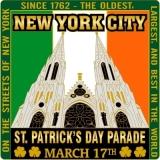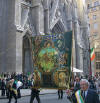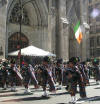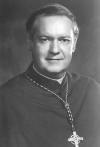|
Saint Patrick's Day Parade .com The Largest Irish Parade Website in the World: "Where the Irish Meet on the Internet for Parade Information" |
|
Collect all (4) High Quality Limited Edition Collector Pins now, while they last.
Attention: All Bands, Pipers, Step Dancers and Irish Organizations click here |
|
|
|
Collect all (4) High Quality Limited Edition Collector Pins now, while they last.
Attention: All Bands, Pipers, Step Dancers and Irish Organizations click here
2010 New York City Saint Patrick's Day Parade
Tuesday, March 17th, 2008
Starting @ 44th Street and Fifth Avenue @11:00 a.m. The Solemn Pontifical Mass at St. Patrick's Cathedral 50th Street and Fifth Avenue @ 8:30 a.m.
High Definition Video Coming Soon!
2008 Slide Show of the NYC Saint Patrick's Day Parade Over 500Photos
2006 Slide Show of the NYC Saint Patrick's Day Parade Over 500Photos
Congratulations to the 2008 New York City Saint Patrick's Day Parade Grand Marshal Raymond L. Flynn
A tribute to the fighting 69th- Taskforce Wolfhound who served in Iraq and the 19 who were killed in action. Tribute to the "Fighting 69th Infantry", New York Army National Guard,
New York City Saint Patrick's Day Parade Photos
A Tribute to our New York City Fire Department (NYFD)
Former Grand Marshal include: 2007 Grand Marshal Raymond L. Flynn, 2006 Grand Marshal Timothy J. Rooney, 2005 Grand Marshal Denis P. Kelleher, 2004 Grand Marshal Thomas W. Gleason and 2003 James G. O'Connor was the Grand Marshal the year before, and Mayor Bloomberg marched along with nearly 150,000 others proudly wearing the green, as millions gawk along the parade route and watch on TV. Six year ago marked the 241st New York St. Patrick's Day Parade, the world's largest. Edward Cardinal Egan was the Grand Marshall, and Mayor Bloomberg will marched along with nearly 150,000 others proudly wearing the green, as millions gawk along the parade route and watch on TV. Several years ago parade was dedicated to the 'Heroes of 9/11, ' including police, fire and all rescue workers. At around midday, the parade will pause for one minute as Cardinal Egan leads participants in a prayer from the reviewing stand at 64th Street and 5th Avenue. It's a reminder that St. Paddy's Day is a religious holiday back in the motherland, even though for New Yorkers it's a chance to party hardy like any good Irishman. There probably isn't a bigger day when green face paint, green food coloring, green nail polish, and green clothes are on display. And there's pure Irish pageantry, of course, led by the 165th Infantry (originally the 69th Regiment of the 1850's). You'll see the Ancient Order of Hibernians, 30 Irish county societies and various Emerald, Irish-language and Irish nationalist societies. The parade marches up 5th Avenue, clan by clan, from 44th to 86th streets starting at 11am on St. Patrick's Day ( March 17th). It will probably be televised on NBC. The first official parade in the City was held in 1766 by Irishmen in a military unit recruited to serve in the American colonies. For the first few years of its existence, the parade was organized by military units until after the war of 1811. At that point in time, Irish fraternal and beneficial societies took over the duties of hosting and sponsoring the event. Originally, Irish societies joined together at their respective meeting places and moved in a procession toward St. Patrick's Old Cathedral, St. James Church, or one of the many other Roman Catholic churches in the City. However, as the years passed, the size of the parade increased and around the year 1851, as individual societies merged under a single grand marshal, the size of the parade grew sharply. Each year a unit of soldiers marches at the head of the parade; the Irish 165th Infantry (originally the 69th Regiment of the 1850's) has become the parade's primary escort, and they are followed by the various Irish societies of the city. Some of the other major sponsors and participants in the parade are the Ancient Order of Hibernians, the thirty Irish county societies, and various Emerald, Irish-language, and Irish nationalist societies. The annual parade down Fifth Avenue to honor the patron saint of Ireland is a New York tradition that dates as far back as 1766. The festivities kick off at 44th Street and Fifth Avenue at 11:00 am on March 17th, with bagpipers, high school bands, and the ever-present politicians making their way up Fifth Avenue to 86th Street, where the parade will probably finish around 4:30 or 5:00 pm. The best viewing spots are toward the north end of the parade route, away from the shopping and work-a-day crowds that throng the sidewalks below 59th Street. Try sitting on the upper steps of the Metropolitan Museum of Art for a great view or catching a close-up view of the marchers where the parade turns east on 86th Street. The New York Convention & Visitors Bureau says that the St. Patrick's Day Parade is the largest and most famous of the many parades held in the city each year. Colonial New York City hosted the first official St. Patrick's Day parade in 1762, when Irish immigrants in the British colonial army marched down city streets. In subsequent years Irish fraternal organizations also held processions to St. Patrick's Cathedral. The various groups merged sometime around 1850 to form a single, grand parade. The parade marches up 5th Avenue, from 44th to 86th streets starting at 11am on St. Patrick's Day ( March 17th). It will probably be televised on NBC. The Central Park transverse roads will stay open to traffic. Pedestrian crossing along the parade route will be allowed on 49th Street to 55th Street, 57th Street and 58th Street, 59th Street eastbound only and 60th Street westbound only.
|
![]() 2006 Slide Show of the NYC Saint Patrick's Day Parade
2006 Slide Show of the NYC Saint Patrick's Day Parade
![]()
Over 500Photos
Installation of Timothy J. Rooney
of the NYC Saint Patrick's day Parade
 |
|
 |
![]() Installation
of Denis P. Kelleher
Installation
of Denis P. Kelleher
of the New York City Saint Patrick's Day Parade
Saint Patrick's Day Parade Photo's
Tribute to the "Fighting 69th"
69th Infantry, New York Army National Guard,
![]() A
Tribute to our New York City Fire Department (NYFD)
A
Tribute to our New York City Fire Department (NYFD)
![]() Saint Patrick's Day Photo's
Page1
Page 2 Page
3
Page 4
Page
5
Page 6
Saint Patrick's Day Photo's
Page1
Page 2 Page
3
Page 4
Page
5
Page 6
|
streets starting at 11am on St. Patrick's Day (Thursday, March 17th). Last year marked the 243rd New York St. Patrick's Day Parade, the world's largest. 2004 Grand Marshal Thomas W. Gleason and 2003 James G. O'Connor was the Grand Marshal the year before, and Mayor Bloomberg marched along with nearly 150,000 others proudly wearing the green, as millions gawk along the parade route and watch on TV. Two year ago marked the 241st New York St. Patrick's Day
Parade, the world's largest. Edward Cardinal Egan was the Grand Marshall,
and Mayor Bloomberg will marched along with nearly 150,000 others proudly
wearing the green, as millions gawk along the parade route and watch on TV. Two years ago parade was dedicated to the 'Heroes of 9/11, ' including police, fire and all rescue workers. At around midday, the parade will pause for one minute as Cardinal Egan leads participants in a prayer from the reviewing stand at 64th Street and 5th Avenue. It's a reminder that St. Paddy's Day is a religious holiday back in the motherland, even though for New Yorkers it's a chance to party hardy like any good Irishman. There probably isn't a bigger day when green face paint, green food coloring, green nail polish, and green clothes are on display. And there's pure Irish pageantry, of course, led by the 165th Infantry (originally the 69th Regiment of the 1850's). You'll see the Ancient Order of Hibernians, 30 Irish county societies and various Emerald, Irish-language and Irish nationalist societies. The parade marches up 5th Avenue, clan by clan, from 44th to 86th streets starting at 11am on St. Patrick's Day (Friday, March 17th). It will probably be televised on NBC. The first official parade in the City was held in 1766 by
Irishmen in a military unit recruited to serve in the American colonies.
Each year a unit of soldiers marches at the head of the parade; the Irish 165th Infantry (originally the 69th Regiment of the 1850's) has become the parade's primary escort, and they are followed by the various Irish societies of the city. Some of the other major sponsors and participants in the parade are the Ancient Order of Hibernians, the thirty Irish county societies, and various Emerald, Irish-language, and Irish nationalist societies. More NYC Irish Pubs - About Saint Patrick's Cathedral
The New York Convention & Visitors Bureau says that the St. Patrick's Day Parade is the largest and most famous of the many parades held in the city each year. The parade marches up 5th Avenue, from 44th to 86th streets starting at 11am on St. Patrick's Day (Friday, March 17th). It will probably be televised on NBC. |
2003 Installation of James G. O'Connor as Grand Marshal
Additional NYC photos Click Here
|
Saint Patrick's Day Photo's Page1 Page 2 Page 3 Page 4 Page 5 Page 6 |
2002 NYC Grand Marshal Edward Cardinal Egan - New York Irish Pubs click here
Additional NYC Parade Photos - NYC St. Patrick's Cathedral










